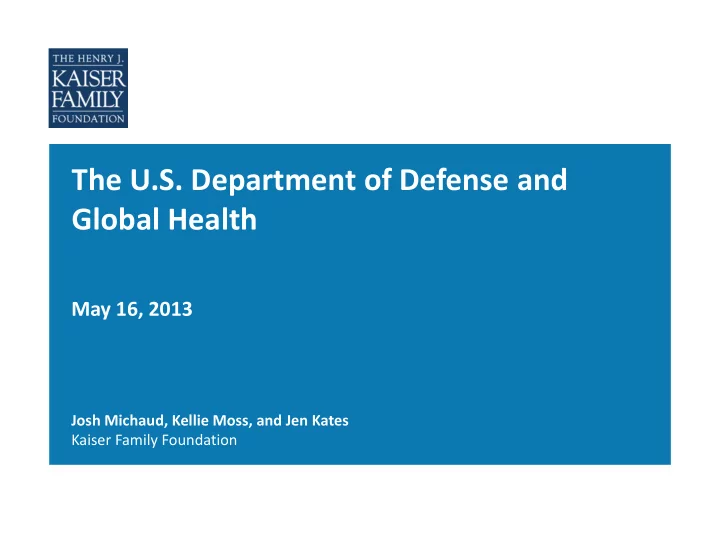

The U.S. Department of Defense and Global Health May 16, 2013 Josh Michaud, Kellie Moss, and Jen Kates Kaiser Family Foundation
History Selected DoD Global Health ‐ Related Milestones 1898 : Philippines military campaign adopts civil ‐ military approach, including use of health projects Prior to 1980 1900 : Army researchers show yellow fever is transmitted by mosquitoes 1903 : Army institutes first successful large ‐ scale malaria prevention program in support of Panama Canal construction 1940s : Military scientists develop first inactivated influenza vaccines 1945 : First Navy overseas laboratory established (in Guam, later moved to Indonesia) 1959 : First Army overseas laboratory established (in Thailand) 1985 : Military researchers develop prototype Hepatitis A vaccine 1991: Cooperative Threat Reduction (CTR) program initiated 1980 ‐ present 1994 : Overseas Humanitarian, Disaster and Civic Aid (OHDACA) funding authority instituted 2003 : Army co ‐ initiates largest ever Phase III HIV/AIDS vaccine trial in Thailand 2005 : DoD Instruction 3000.05 raises “stability operations” to same level of priority as combat operations across the department 2009 : Navy lab first in the world to identify human case of emerging H1N1 pandemic influenza SOURCE: KFF, The U.S. Department of Defense and Global Health, September 2012.
Policy Guidance National Security Strategy (White House, 2010) • “The United States has a moral and strategic interest in promoting global health.” National Strategy for Countering Biological Threats (White House, 2009) • “Many nations struggle daily to address the impact of naturally ‐ occurring infectious disease within their borders…We will seek to advance access to and effective use of technologies to mitigate the impact from outbreaks of infectious disease, regardless of their cause.” Quadrennial Defense Review (DoD, 2010) • “Circumstances are ripe for violent ideologies to spread among a population when governments struggle to provide basic services, justice and security, or the conditions for economic opportunity.” • “Detecting, diagnosing, and determining the origin of a pathogen will enable U.S. authorities to better respond to future disease outbreaks and identify whether they are natural or man ‐ made. Accordingly, we are expanding the biological threat reduction program…in order to create a global network for surveillance and response.”
Focus Areas Force Health Protection and Readiness (FHP) • Medical research and development • Disease surveillance • FHP education and training Medical Stability Operations and Partnership Engagement • Activities to promote stability, reduce conflict, and build relationships and trust with foreign partners Threat Reduction • Prevent and prepare for biological incidents whether due to natural, accidental, or intentional causes SOURCE: KFF, The U.S. Department of Defense and Global Health, September 2012.
DoD’s Organizational Involvement in Global Health SOURCE: KFF, The U.S. Department of Defense and Global Health, September 2012.
Selected DoD Funding Streams Accounts by Focus Area FY 2012 Force Health Protection & Readiness Army RDT&E Infectious Diseases R&D + $60.9 m* Army Overseas Labs Direct Support $3.0 m* Global Emerging Infections Surveillance and Response System (GEIS) $47.2 m* Military HIV Research Program (MHRP) $22.8 m* Navy RDT&E Defense Research Sciences $20.3 m* Navy Lab Support and Navy RDT&E Infectious Disease Research + $37.2 m* USUHS In ‐ House Lab Research $0.4 m* Medical Stability Operations & Partnership Engagement Afghan Security Forces Fund $39.7 m* Commander’s Emergency Response Program (CERP) $28.0 m* Defense HIV/AIDS Prevention Program (DHAPP) $47.2 m* Overseas Humanitarian, Disaster, and Civic Aid (OHDACA) $73.0 m* Threat Reduction Cooperative Biological Engagement Program $259.5 m* * Indicates KFF calculation of the portion of funding under this funding stream that is designated for health projects; see KFF report for methodology. + Indicates this row is a consolidation of multiple budget lines SOURCE: KFF, The U.S. Department of Defense and Global Health, September 2012.
Policy Issues Mission and priorities Support and funding Interagency coordination and communication Public understanding SOURCE: KFF, The U.S. Department of Defense and Global Health, September 2012.
Recommend
More recommend